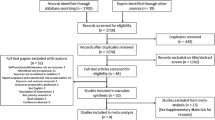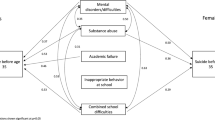Abstract
Objective
Research has demonstrated school effects on health, over and above the effects of students’ individual characteristics. This approach has however been uncommon in mental health research. The aim of the study was to assess whether there are any school-contextual effects related to socioeconomic characteristics and academic performance, on the risk of hospitalization from non-fatal suicidal behaviour (NFSB).
Methods
A Swedish national cohort of 447,929 subjects was followed prospectively in the National Patient Discharge Register from the completion of compulsory school in 1989–93 (≈16 years) until 2001. Multilevel logistic regression was used to assess the association between school-level characteristics and NFSB.
Results
A small but significant share of variation in NFSB was accounted for by the school context (variance partition coefficient <1 %, median odds ratio = 1.26). The risk of NFSB was positively associated with the school’s proportion of students from low socioeconomic status (SES), single parent household, and the school’s average academic performance. School effects varied, in part, by school location.
Conclusion
NFSB seems to be explained mainly by individual-level characteristics. Nevertheless, a concentration of children from disadvantaged backgrounds in schools appears to negatively affect mental health, regardless of whether or not they are exposed to such problems themselves. Thus, school SES should be considered when planning prevention of mental health problems in children and adolescents.
Similar content being viewed by others
References
Gustafsson J-E, Allodi MW, Alin Åkerman B, Eriksson C, Eriksson L, Fischbein S, Granlund M, Gustafsson P, Ljungdahl S, Ogden T, Persson RS (2010) School, learning and mental health. A systematic review. Health Committee, Royal Swedish Academy of Sciences, Stockholm. http://www.buph.se/download/18.2a0ff5f12801fe5f27800010876/kunskaps%C3%B6versikt_skola.pdf
Sellström E, Bremberg S (2006) Is there a “school effect” on pupil outcomes? A review of multilevel studies. J Epidemiol Community Health 60:149–155
Spirito A, Esposito-Smythers C (2006) Attempted and completed suicide in adolescence. Annu Rev Clin Psychol 2:237–266
Barnekow V, Currie C, Letsch C, de Looze M, Morgan A (2009) A snapshot of the health of young people in Europe. A report prepared for the European commission conference on youth health, Brussels, Belgium, 9–10 July 2009. WHO Regional Office for Europe, Copenhagen
National Board of Health and Welfare (2010) Skador och förgiftningar behandlade i sluten vård 2009 (Hospitalisation due to injuries and poisoning in Sweden 2009). www.socialstyrelsen.se
Kalff AC, Kroes M, Vles JSH, Hendriksen JGM, Feron FJM, Steyaert J, van Zeben TMCB, Jolles J, van Os J (2001) Neighbourhood level and individual level SES effects on child problem behaviour: a multilevel analysis. J Epidemiol Community Health 55:246–250
Xue Y, Leventhal T, Brooks-Gunn J, Earls F (2005) Neighborhood residence and mental health problems of 5- to 11-year-olds. Arch Gen Psychiatry 62:554–563
Bernburg JG, Thorlindsson T, Sigfusdottir ID (2009) The spreading of suicidal behavior: the contextual effect of community household poverty on adolescent suicidal behavior and the mediating role of suicide suggestion. Soc Sci Med 68:380–389
Karvonen S, Vikat A, Rimpela M (2005) The role of school context in the increase in young people’s health complaints in Finland. J Adolescence 28:1–16
Saab H, Klinger D (2010) School differences in adolescent health and wellbeing: findings from the Canadian health behaviour in school-aged children study. Soc Sci Med 70:850–858
Zammit S, Gunnell D, Lewis G, Leckie C, Dalman C, Allebeck P (2013) Individual- and are-level influence on suicide risk: a multilevel longitudinal study of Swedish schoolchildren. Psychol Med (published online: 24 April):1–11
Jablonska B, Lindberg L, Lindblad F, Rasmussen F, Östberg V, Hjern A (2009) School performance and hospital admissions due to NFSB: a Swedish national cohort study. Int J Epidemiol 38:1334–1341
Jonsson U, Goodman A, von Knorring AL, von Knorring L, Koupil I (2012) School performance and hospital admission due to unipolar depression: a three-generational study of social causation and social selection. Soc Psychiatry Psychiatr Epidemiol 47:1695–1706
OECD (2005) School factors related to quality and equity: results from PISA 2000. Organisation for Economic Cooperation and Development, Paris. http://www.pisa.oecd.org/dataoecd/15/20/34668095.pdf
Modin B, Östberg V (2009) School climate and psychosomatic health. A multilevel analysis of nearly 20,000 ninth grade students in the larger Stockholm area. Sch Eff Sch Improv 20:433–455
Lee MT, Wong BP, Chow BW (2006) Predictors of suicide ideation and depression in Hong Kong adolescents: perceptions of academic and family climates. Suicide Life Threat Behav 36:82–96
Marsh HW (1984) Self-concept: the application of a frame of reference model to explain paradoxical results. Aust J Educ 28:165–181
Aberg-Bengtsson L (2009) The smaller the better? A review of research on small rural schools in Sweden. Int J Educ Res 48:100–108
The Swedish National Agency for Education (2009) Vad påverkar resultaten i svensk grundskola? Kunskapsöversikt om betydelsen av olika faktorer. (Which factors affect the results of Swedish comprehensive school? An overview of the importance of different factors). Stockholm, Fritzes
Rasbash J, Steele F, Browne W, Prosser B (2004) A user’s guide to MLwiN Version 2.10. Centre of Multilevel Modelling, Institute of Education, University of London, London
Larsen K, Merlo J (2005) Appropriate assessment of neighborhood effects on individual health: integrating random and fixed effects in multilevel logistic regression. Am J Epidemiol 161:81–88
Young R, Sweeting H, Ellaway A (2011) Do schools differ in suicide risk? The influence of school and neighbourhood on attempted suicide, suicidal ideation and self-harm among secondary school pupils. BMC Public Health 11:874
Merlo J, Chaix B, Ohlsson H, Beckman A, Johnell K, Hjerpe P, Rastam L, Larsen K (2006) A brief conceptual tutorial of multilevel analysis in social epidemiology: using measures of clustering in multilevel logistic regression to investigate contextual phenomena. J Epidemiol Community Health 60:290–297
Page A, Lewis G, Kidger J, Heron J, Chittleborough C, Evans J, Gunnell D (2013) Parental socio-economic position during childhood as a determinant of self-harm in adolescence. Soc Psychiatry Psychiatr Epidemiol. doi:10.1007/s00127-013-0722-y
Due P, Lynch J, Holstein B, Modvig J (2003) Socioeconomic health inequalities among a nationally representative sample of Danish adolescents: the role of different types of social relations. J Epidemiol Community Health 57:692–698
Goodman E, Huang B, Wade TJ, Kahn RS (2003) A multilevel analysis of the relation of socioeconomic status to adolescent depressive symptoms: does school context matter? J Pediatr 143:451–456
Gutman LM, Feinstein L (2008) Children’s well-being in primary school: Pupil and school effects. Institute of Education, Centre for Research on the Wider Benefits of Learning, London
Zammit S, Lewis G, Rasbash J, Dalman C, Gustafsson J-E, Allebeck P (2010) Individuals, schools, and neighborhood. A multilevel longitudinal study of variation in incidence of psychotic disorders. Arch Gen Psychiatry 67:914–922
Ringbäck Weitoft G (2003) Lone parenting, socioeconomic conditions and severe ill-health. Dissertation, Umeå University
Pong S (1998) The school compositional effect of single parenthood on 10th grade achievement. Sociol Educ 71:23–42
Bradshaw CP, Sawyer AL, O’Brennan LM (2009) A social disorganization perspective on bullying-related attitudes and behaviors: the influence of school context. Am J Community Psychol 43:204–220
Kim YS, Leventhal B (2008) Bullying and suicide. A review. Int J Adolesc Med Health 20:133–154
Acknowledgments
The study was supported by The Sven Jerring Foundation.
Conflict of interest
On behalf of all authors, the corresponding author states that there is no conflict of interest.
Author information
Authors and Affiliations
Corresponding author
Rights and permissions
About this article
Cite this article
Jablonska, B., Östberg, V., Hjern, A. et al. School effects on risk of non-fatal suicidal behaviour: a national multilevel cohort study. Soc Psychiatry Psychiatr Epidemiol 49, 609–618 (2014). https://doi.org/10.1007/s00127-013-0782-z
Received:
Accepted:
Published:
Issue Date:
DOI: https://doi.org/10.1007/s00127-013-0782-z




